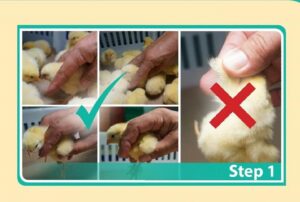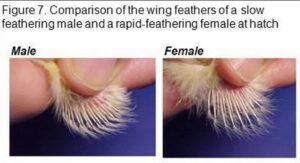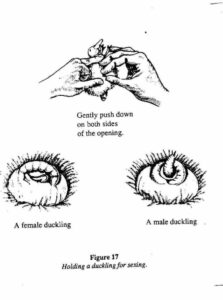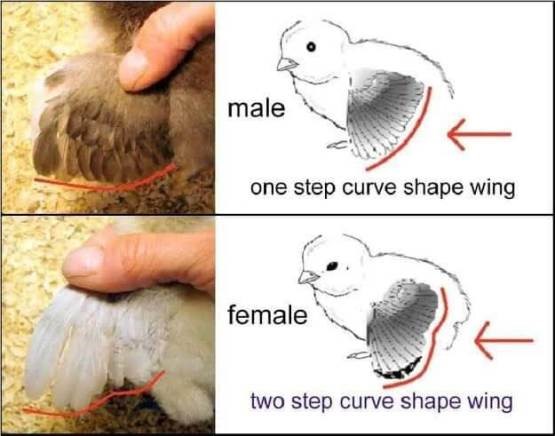Chick sexing is the method of distinguishing the sex of chickens and other hatchlings, usually by a trained person called a chick sexer or chicken sexer. Mostly large commercial hatcheries practice chicken sexing to separate female chicks or «pullets» (to lay eggs) from the males or “cockerels” (most of them are killed within days of hatching due to their irrelevance to egg production). For commercial roles, large number of females and a limited number of males are kept on different feeding programs. Various section of poultry industry requires chick sexing for various reasons. In farms that produce eggs, males are unwanted; for meat production, separate male and female lines for breeding are maintained to produce the hybrid birds that are sold for the table, and chicks of the wrong sex in either line are unwanted. Chicks of an unwanted sex are killed almost immediately to reduce costs to the breeder.
Methods of chick sexing
Several methods are used determine the sex of a day-old chick. Some are effective only with certain breeds or crosses, while others are universal. The two chief methods of sexing chicks are feather sexing and vent sexing.
Vent sexing:

Venting, also known simply as vent sexing, involves squeezing the feces out of the chick, which opens up the chick›s anal vent (called a cloaca) slightly, allowing the chicken sexer to see if the chick has a small “bump”, which would indicate that the chick is a male. Some females also have bumps, though they are rarely but not as large as those of male chicks. The eminence or genital organ is observed halfway at the lower rim of the vent and looks like a very small pimple. Maximum males have an extraordinarily prominent eminence, maximum ladies have none. However, a small percentage of both males and female have highly small eminences. When learning to intercourse chickens, it’s miles first-rate to expect that chickens with small eminences are female. The male eminence is strong and will no longer disappear upon gentle rubbing with one’s thumb. Vent sexing was developed in Japan and in 1930s, it was taken to North American poultry producers. Vent sexing is an ability that takes a long time to increase. It includes maintaining the chick the other way up in a single hand, expelling the faecal material, and everting (turning outward) the vent area. The character can then search for the presence or absence of a rudimentary male sex organ. This technique sounds a good deal simpler than it really is. To appropriately sex chicks in this manner, individual want to be properly educated and to have had an outstanding deal of practice.
Feather sexing:
The sexlinked slow-feathering gene can be used in the crosses where the sex of the chicks can be ascertained at hatching time by the length of the wing feathers. A cross between a fast-feathering male and a slowfeathering female results in chicks in which females have primary wing feathers that are significantly longer than the coverts. The male chicks have shorter primary wing feathers, almost the same length as the coverts.

Feather sexing day old chicks in the Hatchery
* It is important to sort day-old chicks by sex at the hatchery.
*To identify females for further selection.
*To distinct male and female broilers to manage them according to their differing requirements.
For example, Rhode Island Red and New Hampshire breeds can be sexed by observing wing color at hatching. White spot on the down over the wing web can be seen in male chicks. This spot is lost when the chick down is shed and replaced with feathers. But sexing in this way is not always accurate as there is considerable normal variation in the size of the spot. The Barred Plymouth Rock breed carries a gene for barring (B) that is carried on the Z chromosome. This gene produces a white bar on an otherwise black feather. The gene is incompletely dominant over the non-barring gene (b). In adults, the male, with two barring genes (BB), has feathers with broader white bars than those of the female, who has only one of the barring genes (B_). As a result, females are overall lighter in color. The sex of purebred Barred Plymouth Rocks chicks can be determined based on the size and shape of a light-coloured spot on the top of the head. Large white spot at hatch is present in males. In females, the spot is much smaller and narrower. This has been found to be about 80% accurate.
Advantages as compared with vent sexing:
* People can be trained to feather sexing quickly with good speed and accuracy.
*Feather sexing can be done at fast rate (up to 4,500 chicks per person per hour).
*Less chances of infection and cost effective.
Other methods Colour sexing:
Colour sexing:
The sex-linked silver/gold (Ss) gene can also be used to sex newly hatched chicks. S females mated with S males give birth to offspring, females have a darker, leathery downcolor, and males have a brighter, whiter downcolor. Unless concealed by other colors (controlled by other genes), chicks can be sexed accurately with little or no training. Auto-sexing breeds: In 1930, two English geneticists elaborated the principle of sex linkage to sex identification of baby chicks without depending to breed crosses. This method is known as autosexing, it involves the interaction of a sex-linked genethe barring gene with certain other genes in a pure-breeding variety or strain of chickens. Males carry two genes for barring which modify the color or pattern expressed in the chick down feathers by the action of other genes in a more severe fashion than one barring gene in females. This method enables the development of a purebreeding variety in which the sexes consistently appear distinct at hatching. Some of the inherited traits in chickens with which the barring gene will interact to give autosexing are parallel penciling, a striped chick down pattern, and the down pattern of mottled breeds like the Ancona.
Semi-auto-sexing breeds:
Newly hatched Barred Rocks, Rhode Island Reds, and New Hampshire Reds can be sexed distinctly with fair accuracy. With Barred Rocks, the males have a large, distinct white head spot and yellow feet whereas females have a smaller, less well-defined head spot and darker feet. Rhode Island Red and New Hampshire Red chicks with chipmunk stripes are mostly females.
Alternative methods:
Small scale poultry owners can’t afford a chicken sexer therefore, to avoid waiting for a long period of 4-6 weeks to attain the observable distinction in characters, there are provision of some alternative methods of sexing the chicks.
In-ovo sexing:
Automated systems to determine the sex of the developing chick long before hatching have been announced but not widely deployed. A high accuracy of 97% in 14-day inovo experiment was reported in 2017. The system relies on candling eggs and using spectroscopy to determine feather colour, and hence is suitable only for strains with sex-linked feather colouration.
Machine sexing:
Due to nonavailability of instruments and spare parts of machine sexing, there is not widely used. The Keeler Optical (English) or Chick tester (Japanese) machine features a blunt-ended telescopic tube, containing a light. The chicken sexer inserts the tube into the evacuated cloaca and with the help of the light can identify either testis or ovaries.
With most animals, it is relatively easy to determine the sex of the newborn. The male reproductive organs are located on the outside of the body and are relatively easy to see, even in newborns. This is not the case with poultry. In male birds, the reproductive organs are inside the body cavity. This makes sexing newly hatched chicks difficult. Therefore, various methods of chick sexing were developed to sex the chicks as early as possible to assort the chicks for different purposes like egg production or meat production or to develop as breeder flock.
Method For Sexing Of Chickens
The method of segregation of male and female chickens and other birds is called sexing of chickens. It is essential for breeder and layer chicks at day old stage. Sexing of chicken is also important for the breeding of poultry.
Procedure for Sexing Of Chickens
The main procedure for Sexing of different types of Chickens depends on types of chicken and Poultry. The sexing procedure must be followed through day Old stage. Sexing procedure is mainly followed on
- chicks
- quail
- turkey
Sexing of Chicks
The sexing of chicks is performed by the best three methods-
- Vent (Cloacal) or Japanise method of sexing
- Proctoscopic method of sexing
- Sex-linked characters
- Vent ( Cloacal method)
It is also called the Japanese method of sex. This method was first developed in Japan and considered to be the most popular method of the recent time. The sexing is done on the basis of the genital eminence of the day-old chicks.
Differential characters of vent sexing in chicks ( Table)
| Characters | Male | Female |
| The elasticity of genitalia eminence | More elastic | Les Elastic |
| Boundary and contour of genitalia eminence | Distinct Boundary and contour | No Distinct Boundary and contour |
| lusture and color of eminence | Distinct Lusture | Transparent appearance, Color does not differ from other parts of the cloaca |
| The difference of position of eminence | Much more outside | Further inside |
Illustrator, Jean E. Hirsch (Canfield, 1950)
Differentiation of Male and female chicks by genital eminence
| Left – Cockrel | Reight – Pullet |
Illustrator, Jean E. Hirsch (Canfield, 1950)
Methods for Vent sexing in chicks
- Hold chick in one hand firmly but gently with chicks rear-facing you over that can be cleaned easily.
- Press gently on the abdomen, then gently squeeze its vent with the thump and first finger of the other hand.
- Clear the Faeces of the vent.
- Carefully spread the vent using your bump and index finger and cause the tissue just inside the vent to be visible.
- Check if the chick has a small bump which would indicate that the chick is male.
- Chicks with no visible bulge or just a slight indentation can be classified as female.
- Place males in one box and female in another box
- Proctoscopic method
Proctoscope is an optical instrument with an illuminated glass tip that is inserted into the chick’s bowel through the cloaca, enabling the sexer to view the testicle of the cockerel or the ovary (left) of the pullet.
- Sex- linked sexing
It is described by the two fundamental methods of sexing-
a) Colour of plumage
In this method, sex-linked characters are used to identify the sexes of chicks. For example, when a Rhode Island Red male is mated to a Barred Plymouth Rock female, all the female progenies will be black and male progenies barred.
b) Feathers Growth
Slow-feathering and rapid-feathering genes are used in breeding programs so that the sex of day old chicks can easily be determined. Feather sexing is common in layer and broiler parent stock.
Steps for Feathers sexing of Day old chicks
- Step 1- Pick up the chick by gently holding the neck between the index and middle finger. Ring and little finger will automatically support the rest of the chick body
- Step The chick wing will present between the thumb and index finger, bring your upwards pushing gently against the index finger. This will spread the wing open facing toward
- Step 3-Look into the covert and primary feather and determine whether the chick is a male or female
- Step 4-Gently place the sexed chick into the appropriate box or chute. When sexing parent females, any chicks that are not clearly female should be put with the male off sexes.
HOW TO KNOW THE SEX IN CHICKS
According to Feather sexing a chicken, also referred to as wing sexing, is another fairly easy and straight-forward way to sex a chicken. As with venting, to use this method, you must do it when a chick is about a day old. If you wait much longer, its feathers will be well-developed, and you’ll be unable to see differences between males and females.
Female chicks will have wing feathers earlier than male chicks, developing them before hatching. Males, on the other hand, start developing their wing feathers after hatching. This means that wing feathers are going to be much more visible in day-old female chicks than males.
The wing feathers of day-old male and female chicks look remarkably different. Female chicks have alternating feather lengths on their wings. There will be a long one, followed by a short one, then another long one, and so on and so forth. By contrast, male chicks’ wing feathers will all be the exact same.
Sexing by feathers growth
Age of Sexing in chicken
The best age of sexing in chicken at day old or hatch day due to identification points of sexing easily differentiate from rooster or male-female chicks. Identification points are vent, primary feathers, etc.
What are chicken breeds that can be sexed at birth?
The breed which is sexed at birth also called Autosexing breeds. the Cream Legbar which is called autosexing breed results from a careful mix of Araucana, Brown Leghorn, and Gold Legbar. The final result is a pretty bird that is a prolific layer of blue eggs
Sexing of Rooster chickens
It easily tells which is rooster chicken according to the characterization of genital eminence and feathers in chicken. characterization of genital eminence points of chicken are- elasticity, boundary, and contour, position, etc.
Duckling Sexing

It is also determined in two stages with two methods of sexing-
- Japanese or Vent Method
- (b) Sexing of Duck (adult
a) Japanese or Vent Method
The color of the cloaca of day-old male duckling appears to be pinker than that of female ones.
b) Sexing of Duck (adult)
| Characters | Male | Female |
| Squawk ( six weeks of age) | Not so pronounce | Much more pronounced |
| Tail Feather | Turned upside | No such turning |
| Color of Plumage | Darker | less dark |
Sexing duckling
How to differentiate Kaki Campbell Male and Female duck
- Male-Color of the plumage of the neck is bluish-black
- Female- The color of the plumage of the neck is chocolate
Sexing of Quail
The procedure of sexing quail by the following three process-
- Day-old stage
- Three weeks of age
- Five to six weeks of age
| Day-old stage | It is not practiced due to the very small size of birds 9(each weighs about 6gm) |
| Three weeks of age | Female- Darker cinnamon color feathers on the upper throat and lower breast region. Feathers are short and blunt. Female- Lighter cinnamon color feathers on the upper throat and lower breast region and characteristic black stippling, Feathers are long and pointed |
| Five to six weeks of age | Male- makes peculiar sound particularly during the night. |
quail sexing
SEXING OF OTHER BIRDS
The venting method is also used for sexing turkeys, guinea fowls, geese, ostriches, and emus at the day-old stage.
Auto sexing Breeds
The autosexing breed is defined as purebred birds that can be sexed at hatch, generation after generation, based upon markings and coloration. It is are derived from breeds with barred markings crossed with other specific breeds. its often developed from a cross between two breeds. Some autosexing breeds are-
- the Cream Legbar- Results from a careful mix of Araucana, Brown Leghorn, and Gold Legbar. The final result is a pretty bird that is a prolific layer of blue eggs
DR RIYAZ AHMAD, AMU


